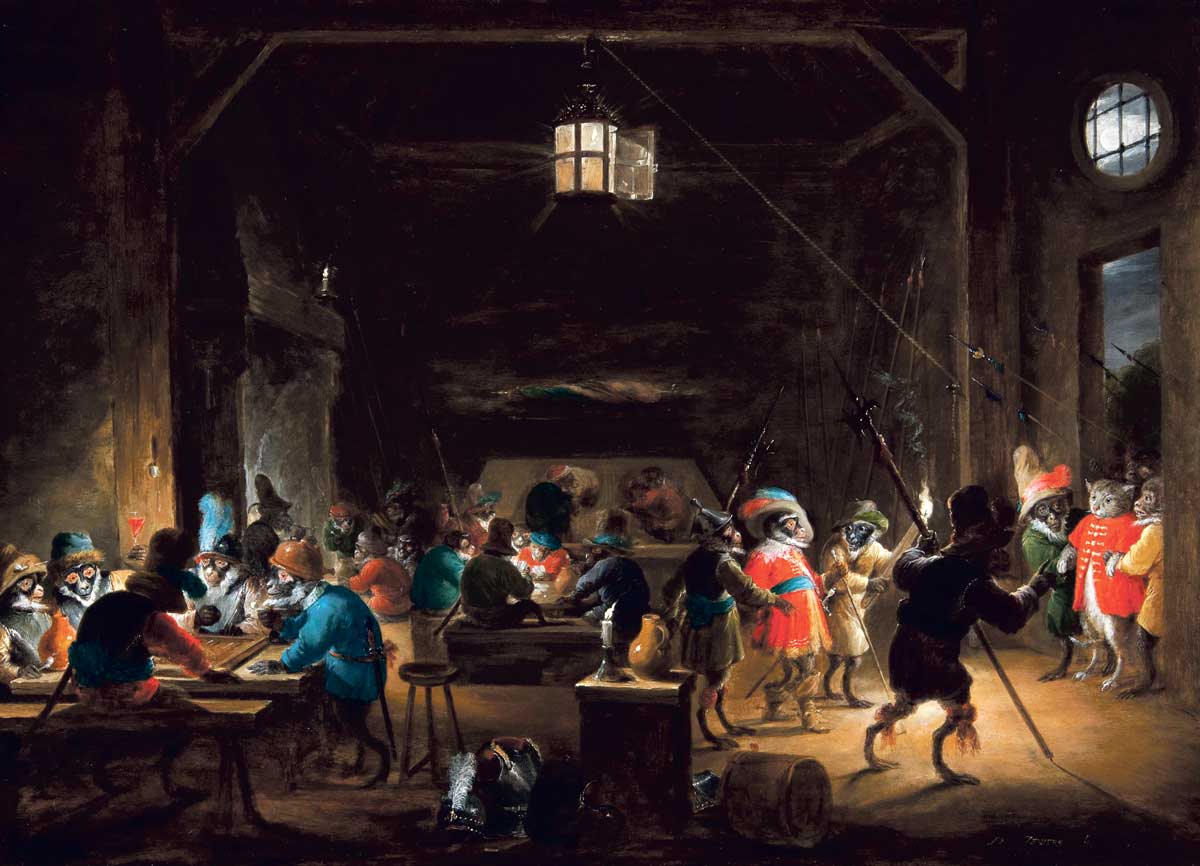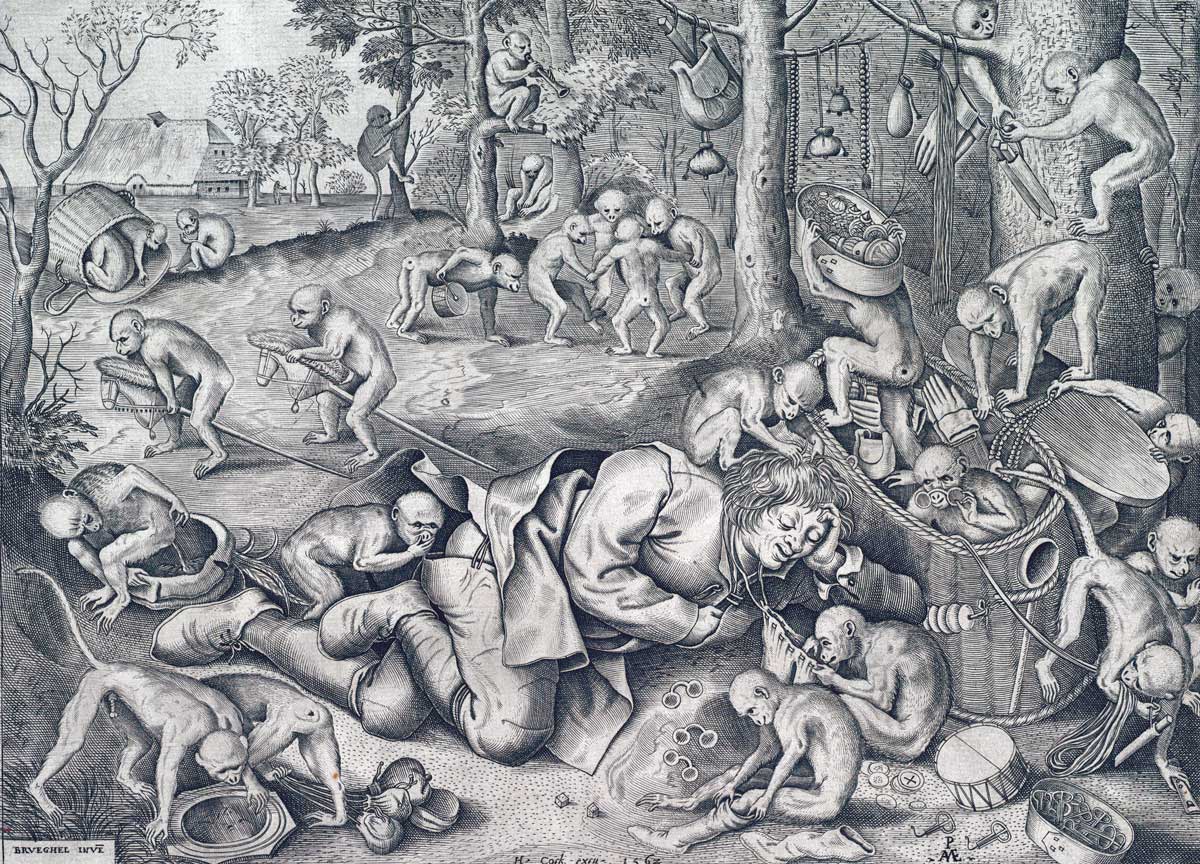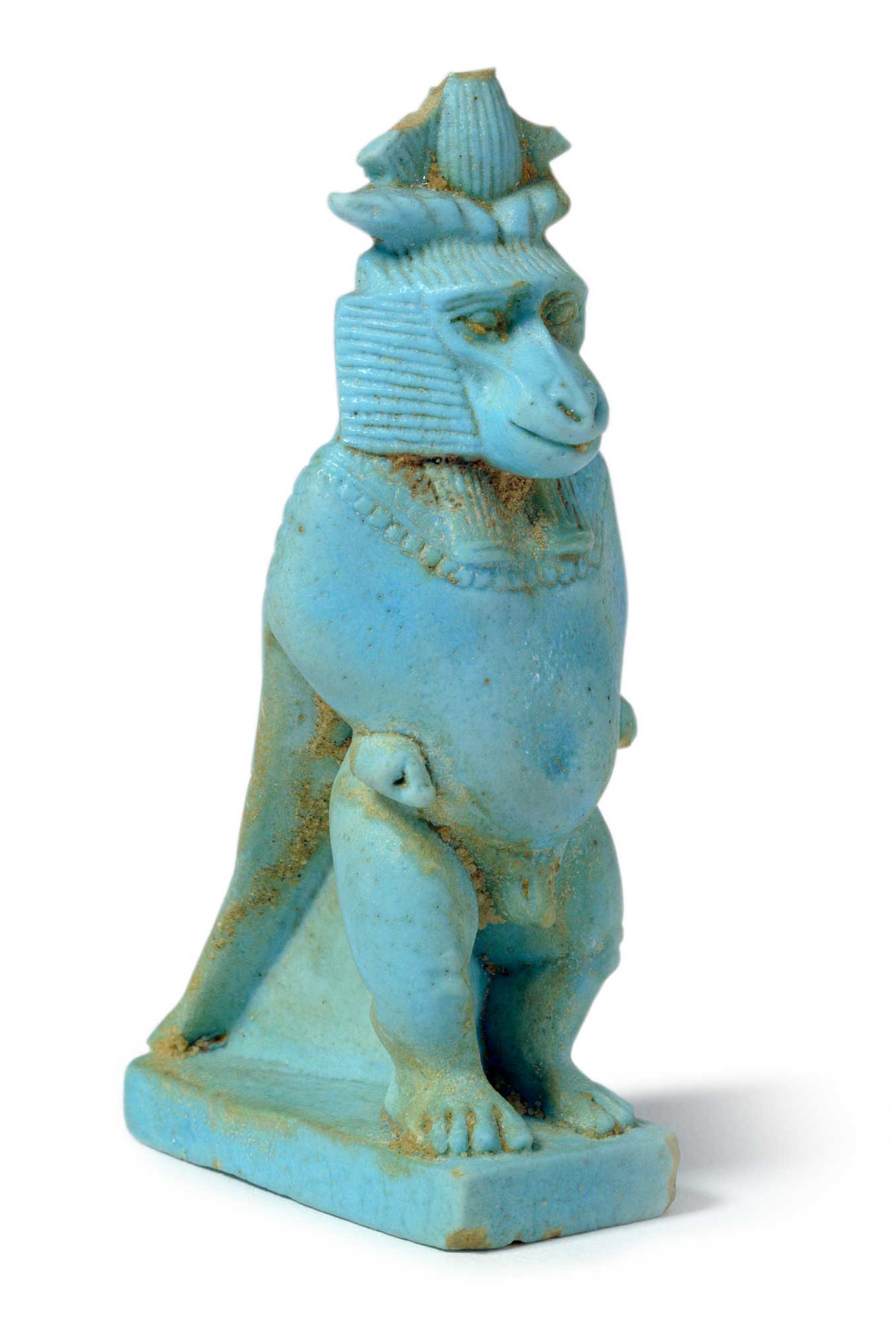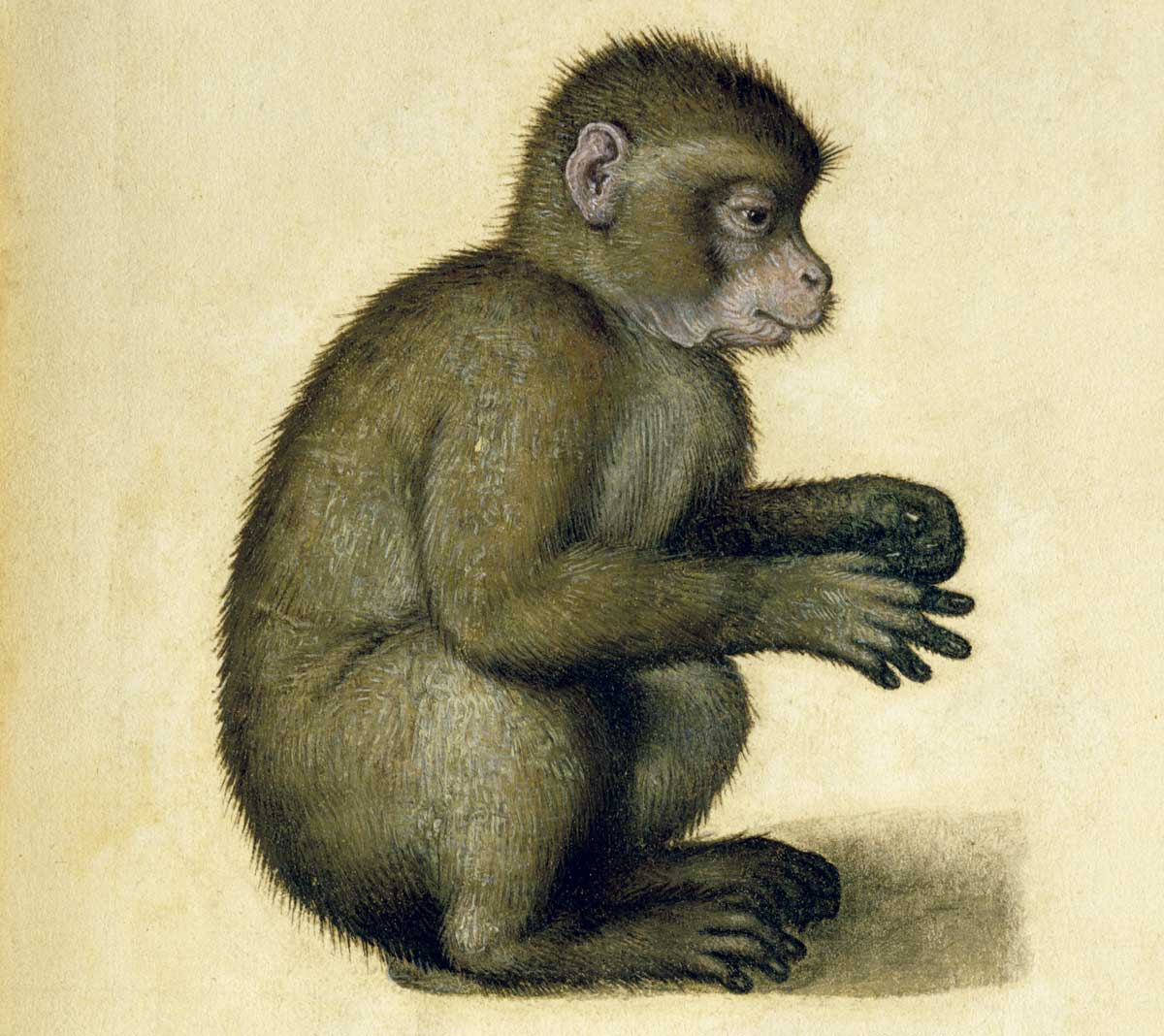A History of Monkeys | History Today - 10 minutes read

In 1562, an etching by Pieter van der Heyden turned the Dutch art world upside down. Modelled after a painting by Pieter Bruegel the Elder, it depicted a well-known folk story. In the middle of the scene, a peddler lies sleeping beneath a tree. As he is slumbering, however, he is fallen upon by a troop of monkeys. Small in size but with a distinctly human appearance, they get up to all kinds of mischief. After rifling through the peddler’s basket, some amuse themselves with his wares. One tries on a pair of children’s trousers; a second looks at its reflection in a mirror; a third makes off with a set of knives. Another, sitting in a branch, is playing a flute, while its friends dance; two more are having a hobby horse race. Meanwhile, members of the band torment the peddler himself. One is urinating in his hat; another is searching for nits in his hair; one is stealing from the purse hanging about his neck; yet another is holding its nose while it exposes the poor man’s bottom.
Moralising monkeys
This wasn’t the first time monkeys had appeared in European art. Since the earliest times they had appeared in artworks of all kinds – often as part of moralising allegories, to add decorative spice to otherwise humdrum scenes, or simply for the sake of amusement. They are found in the wall paintings of Egyptian tombs; in Minoan frescoes on Crete and Akrotiri; and in Roman sculptures and friezes. They peek out from the margins of illuminated manuscripts and can even be found on the façades of Gothic cathedrals such as Rouen. Following Columbus’ (re-)discovery of the New World in 1492, they had even enjoyed a ‘Renaissance’. In 1523, Albrecht Dürer had produced a print for his Protestant friends in Geneva showing a troupe of dancing monkeys; and in 1540-45, the Vicentine engraver Niccolò Boldrini had produced a woodcut – probably after a design by Titian – of the recently rediscovered Laocoön, in which the human figures were replaced by apes. Bruegel himself had made several studies of monkeys before tackling the Sleeping Peddler Beset by Monkeys, including one showing two chained colobus monkeys in a window overlooking the port of Antwerp, generally thought to be an allegory of passion restrained.
But van der Heyden’s etching marked the beginning of something new. While it was not the first artistic depiction of monkeys – or even the first treatment of the Sleeping Peddler tale – its appearance marked the beginning of a veritable craze for simian art. Dutch collectors clamoured for paintings and etchings. So great was the demand that, within a few years, monkey-pictures came to be regarded as a distinct genre, later known as singerie (‘monkey games’). The way monkeys were portrayed changed, too. Where they had previously been used mostly for metaphorical or ornamental purposes, they came to be more often found in parodies. Dressed in human clothes, performing human actions, or actively intervening in human affairs, they were deployed to ridicule aspects of human life or specific people, often cruelly.

The monkey craze van der Heyden helped inspire was fuelled by his contemporary, Pieter van der Borcht. After producing his own version of the Sleeping Peddler, he engraved a series of everyday scenes in which monkeys took the place of men. The most admired was The Nursery (c.1585). Abounding in the barbed whimsy that was to become the hallmark of later singerie, this was a satire on familiar, rose-tinted depictions of childrearing and a comical warning against idealising children themselves. It was, however, only a generation later that the potential of the genre was fully realised. In the early 17th century, Frans Francken the Younger launched a scathing attack on contemporary mores in Monkeys in the Kitchen (1620) and Monkeys playing Backgammon (date unknown); Jan Breughel the Elder replaced van der Heyden’s rather crude, bear-like monkeys with carefully drawn portraits, taken from life; and Jan Breughel the Younger broadened the scope of simian satire still further with a broadside against tulipmania (1640). Yet by far the most talented of all was David Teniers the Younger. The son-in-law of Jan Breughel the Elder, Teniers made singerie his speciality and, in paintings like The Guardroom with Monkeys (c.1633), succeeded in elevating monkey paintings to new heights of perfection.
Kunstkamers and clans
But where did this fashion for monkey painting come from? According to Bert Schepers, a leading expert on Dutch singerie, there is unlikely to have been a single cause. Rather, it was a combination of different factors. Of these, two are often said to have been particularly important. The first is the emergence of the kunstkamer – literally, an ‘art room’, but perhaps better translated as a ‘cabinet of curiosities’. Though its precise origins are still debated, this came into its own in the late 16th century and was especially popular among the wealthy burghers of Antwerp. As the German artist Gabriel Kaltemarckt observed in 1587, there were three things which every kunstkamer should contain: curious items from abroad, artefacts of strange animals (claws, antlers, narwhal tusks, stuffed crocodiles etc) and – crucially – works of art. These could be on any subject, as long as it piqued the imagination or tickled the humour. Genre scenes, ‘gallery paintings’, landscapes, still lifes and interiors were all popular. But singerie – which combined a shrewd observation of nature with a biting wit – were ideally suited to the peculiar demands of such rooms.
The second reason is the dominance of certain artistic families. Throughout the late 16th and 17th centuries, a narrow group of tightly knit clans – centred on Antwerp – exercised a disproportionate influence over the development of Dutch art. Among the most important were the van der Borchts, the Breughels, the Franckens and the Teniers. Though not all their works enjoyed the same success, they were so renowned that whatever they favoured became the fashion. That they took a shine to monkeys guaranteed singerie’s success.
Debased humanity
But while these reasons may account for the popularity of singerie after the appearance of The Sleeping Peddler, they do not explain what lit the spark in the first place – or why monkeys were suddenly put to parodic, rather than allegorical or decorative, purposes.

Arguably the most plausible explanation is that the Dutch started seeing monkeys in a new way. When van der Heyden produced his engraving, the Dutch Republic was entering a period of economic growth; this was fuelled predominantly by trade, most of all with the East Indies. Following several successful voyages to India, the first Dutch expedition to Indonesia set sail in 1595; and in 1602, the Vereenigde Oostindische Compagnie (VOC, or Dutch East India Company) was founded in Antwerp. Though the VOC made its shareholders hugely wealthy, the most important effect of its activities was vastly to enlarge the Dutch people’s experience of simians. Whereas in the past they had known only a relatively small number of species from North and West Africa, and – to a much lesser extent – the Americas, they were now introduced to a dizzying range of new varieties. Smaller, more gregarious monkeys, such as macaques and langurs, provoked tremendous curiosity – not least because of their intelligence and capacity for imitation. Brought back to Europe by naturalists, sailors and smugglers, they became a familiar presence. Some were kept as pets, others in menageries. The less fortunate were purchased by buskers and forced to perform in the street.
While this excited the artistic imagination enough for Pieter Bruegel the Elder and Pieter van der Heyden to begin including more (East Asian) monkeys in their scenes, it also provoked a dramatic shift in philosophical attitudes towards primates more generally. Before the 16th century, European perceptions of the animal kingdom had been shaped by the Bible. While God had created man in His image and likeness, He had created animals as a lesser, more imperfect form of life. Monkeys were, however, sometimes regarded as a special case. Though they were obviously not human, they shared enough characteristics with mankind to be thought of as a form of humanity, albeit debased. After all, as the Flemish anatomist Andreas Vesalius pointed out, they bore a strong physiological resemblance. They also had similar social habits and could be trained to behave in a strikingly human fashion.
In the early 17th century, however, this began to change. Observing the new species of monkey being brought over from the East, the philosopher René Descartes was struck more by their difference than by any similarity. Monkeys were, he stressed, fundamentally irrational beings. While they could imitate human behaviour with remarkable ease, they did so without understanding. They could hence be treated with disdain – even contempt. Nicolas Malebranche went even further. Building on Descartes’ denial of simian reason, he argued that monkeys, like other animals, could neither suffer pain nor experience emotion. As such, they did not merit moral consideration. They could thus be mistreated, brutalised or even vivisected at will.

This had serious repercussions for how monkeys were represented in art. As long as they had been seen as a lesser form of humanity, there was nothing to stop them being used a metaphor for our more ‘animalistic’ impulses, or as charming divertissements. There was no need to portray them as anything but themselves, or to have them behaving in any manner except their own. But now that they were regarded as divorced from humankind, it seemed logical to exploit the perceived differences for the purpose of mockery. By placing them in human situations, it was possible to mock the irrationality or stupidity of those whom they were meant to represent. Indeed, the more ‘human’ they were made to look, the more ridiculous – and pointed – the satire.
Long shadows
Sadly, such dark clouds cast long shadows. Over the centuries which followed, the fascination for monkey scenes continued to grow throughout the 18th century and well into the 19th. Having emerged in the Low Countries, they now spread to France and England; and, though inspired by Dutch contact with the East Indies, they were gradually overlaid with a new passion for Chinoiserie. The types of monkey depicted changed, too. The unpleasant philosophical attitudes upon which singerie had been based, however, remained the same. Though monkeys’ mischievousness might sometimes inspire a certain affection, there was still an unbridgeable gap separating them from men. Their perceived irrationality took centre stage. Christophe Huet used them to ridicule French landowners; Edwin Landseer to mock English naturalists; Honoré Daumier to poke fun at King Louis-Philippe; and Jean-Baptiste-Henri Deshays – among others – to laugh at painters themselves.
Not until the publication of Charles Darwin’s revolutionary work, On the Origin of Species (1859), did monkeys (and apes) begin to emerge from the shadow first cast by the artists of the Dutch Golden Age. Once a clear link was drawn between simian and human origins, it was recognised that any dissimilarities were far outweighed by similarities – and the use of monkeys to parody, mock and degrade began gradually to decline. The correction is, however, still far from complete. Just as Darwin’s views were met with resistance from creationists such as Samuel Wilberforce, so in some quarters, our simian cousins continue to be treated with disdain and cruelty – and depicted in ways that do neither them nor us any credit. This has to change. If we don’t want to look as foolish as van der Heyden’s peddler, it’s about time we made a monkey out of ourselves and treated monkeys with the respect they deserve.
Alexander Lee is a fellow in the Centre for the Study of the Renaissance at the University of Warwick. His next book, Machiavelli: His Life and Times, will be published by Picador in March 2020.